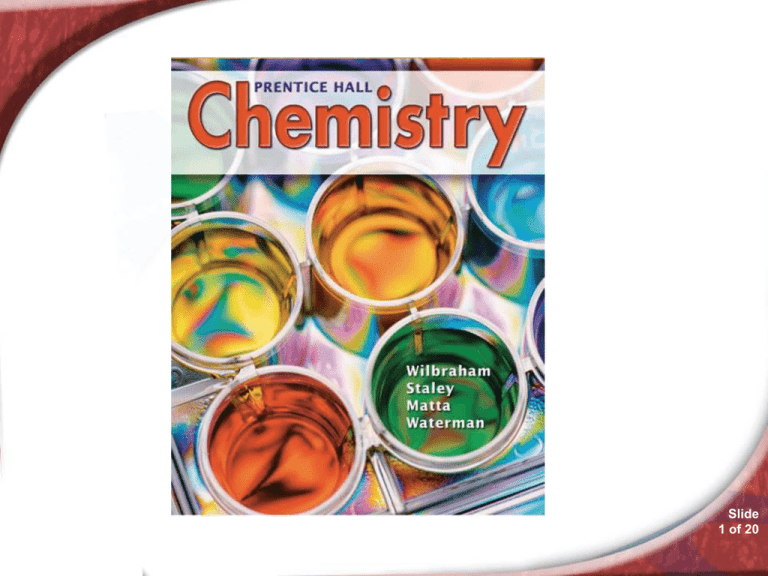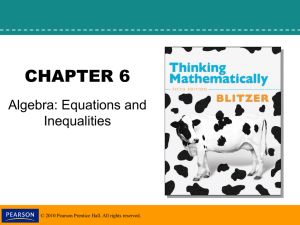
Chemistry 24.4
Slide
1 of 20
24.4
Lipids
Before the invention of
electric lighting, wax
candles were a major
source of lighting in
homes. In this section, you
will read more about
waxes and similar
compounds that make up
the class of biomolecules
known as lipids.
Slide
2 of 20
© Copyright Pearson Prentice Hall
24.4
Lipids
>
Triglycerides
Triglycerides
What physical property distinguishes
lipids from other classes of biological
molecules?
Slide
3 of 20
© Copyright Pearson Prentice Hall
24.4
Lipids
>
Triglycerides
Fats, oils, and other water-insoluble compounds
are called lipids.
Slide
4 of 20
© Copyright Pearson Prentice Hall
24.4
Lipids
>
Triglycerides
Natural fats and oils exist as triesters of glycerol
with fatty acids, which are long-chain carboxylic
acids (C12 through C24). This form of lipid is
known as a triglyceride.
Slide
5 of 20
© Copyright Pearson Prentice Hall
24.4
Lipids
>
Triglycerides
Slide
6 of 20
© Copyright Pearson Prentice Hall
24.4
Lipids
>
Triglycerides
Lipids tend to dissolve readily in
organic solvents, such as ether and
chloroform, rather than in highly
polar solvents such as water. This
property sets them apart from most
biological substances such as
carbohydrates and proteins.
Slide
7 of 20
© Copyright Pearson Prentice Hall
24.4
Lipids
>
Triglycerides
The hydrolysis of oils or fats by boiling with an
aqueous solution of an alkali-metal hydroxide is
called saponification.
Slide
8 of 20
© Copyright Pearson Prentice Hall
24.4
Lipids
>
Triglycerides
A typical saponification reaction is shown below.
Slide
9 of 20
© Copyright Pearson Prentice Hall
24.4
Lipids
>
Triglycerides
Saponification is used to make soap.
Slide
10 of 20
© Copyright Pearson Prentice Hall
24.4
Lipids
>
Phospholipids
Phospholipids
How do phospholipid molecules arrange
themselves in water?
Slide
11 of 20
© Copyright Pearson Prentice Hall
24.4
Lipids
>
Phospholipids
Phospholipids, or lipids that contain phosphate
groups, are abundant in cells.
Slide
12 of 20
© Copyright Pearson Prentice Hall
24.4
Lipids
>
Phospholipids
In water, phospholipids spontaneously
form a spherical double layer, called a
lipid bilayer, in which the hydrophobic
tails of phospholipid molecules are
sandwiched between two layers of
hydrophilic heads.
Slide
13 of 20
© Copyright Pearson Prentice Hall
24.4
Lipids
>
Phospholipids
A cell membrane has a lipid bilayer structure.
Slide
14 of 20
© Copyright Pearson Prentice Hall
24.4
Lipids
>
Phospholipids
Slide
15 of 20
© Copyright Pearson Prentice Hall
24.4
Lipids
>
Waxes
Waxes
Waxes are esters of long-chain fatty acids and
long-chain alcohols.
• Waxes are also part of the lipid family.
• Waxes are low-melting, stable solids.
Slide
16 of 20
© Copyright Pearson Prentice Hall
24.4 Section Quiz.
Assess students’ understanding
of the concepts in Section 24.3.
Continue to:
-or-
Launch:
Section Quiz
Slide
17 of 20
© Copyright Pearson Prentice Hall
24.4 Section Quiz
1. The class of substances called lipids includes
a. proteins.
b. hydrocarbons.
c. soaps.
d. fats, oils, and waxes.
Slide
18 of 20
© Copyright Pearson Prentice Hall
24.4 Section Quiz
2. In water, phospholipids spontaneously form
a. a solution in which the hydrophilic heads
dissociate from the hydrophobic tails.
b. a single layer in which hydrophobic tails are
hydrogen-bonded to hydrophilic heads.
c. a double layer in which the hydrophobic tails are
sandwiched between the hydrophilic heads.
d. a double layer in which the hydrophilic heads are
sandwiched between the hydrophobic tails.
Slide
19 of 20
© Copyright Pearson Prentice Hall
24.4 Section Quiz
3. The selective absorption of nutrients across a
cell membrane occurs in channels formed by
a. lipids.
b. phospholipids.
c. proteins.
d. carbohydrates.
Slide
20 of 20
© Copyright Pearson Prentice Hall
END OF SHOW






